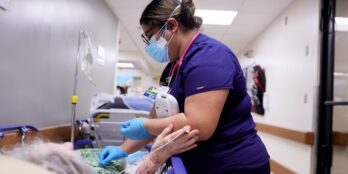
Designing for the New Normal – Infection Control Management
 3 min
3 min
Prior to the start of 2020, our team began focusing on a solution to streamline the workflow for infection prevention and control with a goal of launching to a small group of customers in October 2020. Before we could build a solution, we needed to understand how our customers recorded suspected infections, when and how they reported infections, and what they do to prevent outbreaks. To do this, we brought together an interdisciplinary team to conduct onsite visits and observe how our customers manage infection prevention and control to find ways to improve the experience.
In March 2020, at the start of the COVID-19 pandemic, this solution became more important than ever. Our customers were under a lot of pressure to monitor and report infections at a higher rate than ever before. This meant we needed to speed up the release of the product. We pulled our resources and began building and testing with customers right away, allowing us to release an early-stage product in April. This first phase allowed customers to self-enable, self-learn and begin monitoring and tracking infections immediately.
Discovery and goals
What we discovered during our visits and conversations was that it takes the whole care team to properly monitor infections.
We found 3 main gaps in the current workflow.

Based on our findings, and the shortened timeline, we decided to focus on 3 main goals for the new design.

Solution
When an assessment is completed with abnormal findings, a lab result indicating infection is received, or a new antibiotic order is written, that information flows to a central workspace. The central workspace serves as an efficient method of communication for the whole care team. Dashboards and reports within that solution allow for consolidation of information for reviewing patterns or trends, and completing required reporting. Monitoring these dashboards and reports can help the care team determine the best way to prevent potential outbreaks.
Rollout and Outcome
With the time constraints put on our customers by the pandemic, we needed to give customers the ability to turn the solution on and begin using it immediately with minimal initial training time. In-app learning was implemented to help guide the customer through the enablement process and walk them through the solution, giving them tips when and where they needed them. We worked closely with our support team to monitor the needs of our customers as they began using the new solution. When support calls started coming in about difficulty understanding the enablement process, we were able to update the in-app learning to give more detail, including images of the process, which proved successful with an immediate decrease in support calls. The COVID-19 pandemic caught the world off guard and managing infections is more important than ever before. The rollout of this solution has transformed the workflow of many senior facilities across North America. The solution has standardized communication and documentation and has made monitoring and reporting infection cases more efficient. Since adoption, we have seen an 89% decrease in COVID-19 cases, a 64% decrease in all other infection cases, and an average savings of 45‐60 minutes a day by eliminating manual data entry.
October 15, 2021






